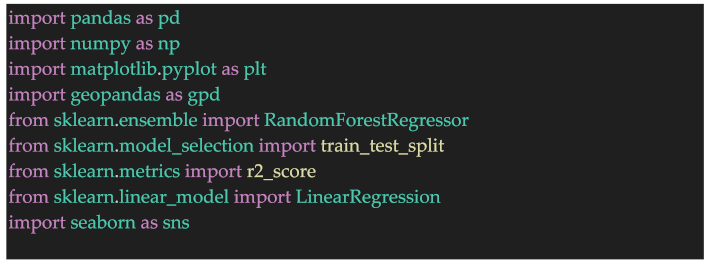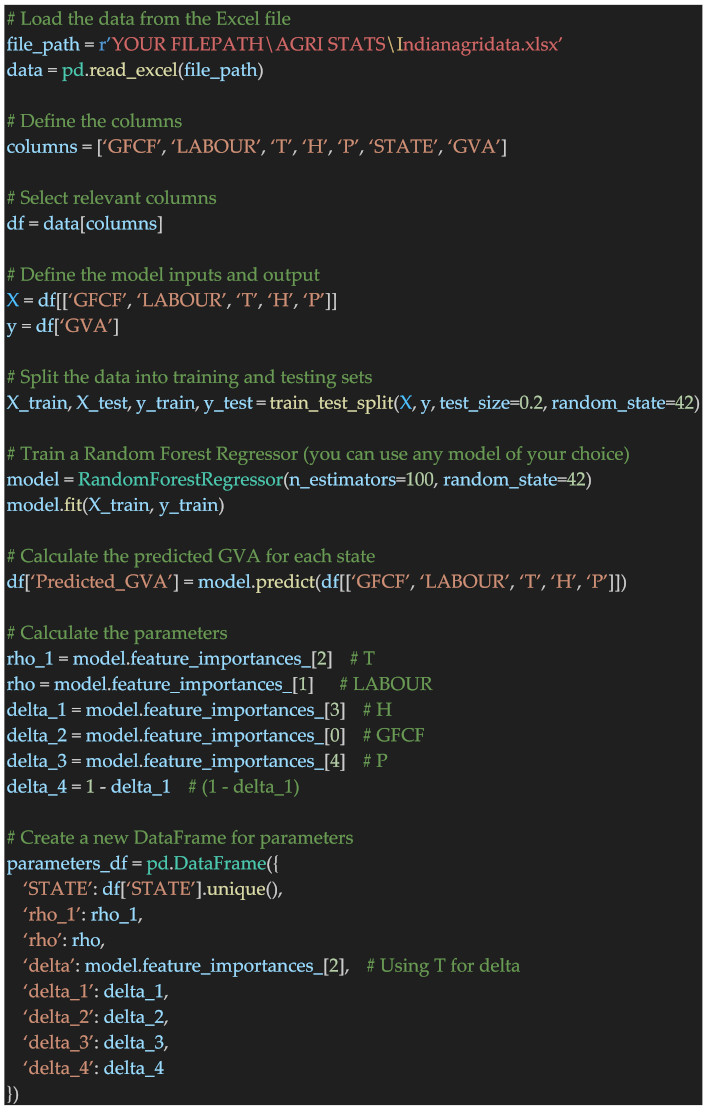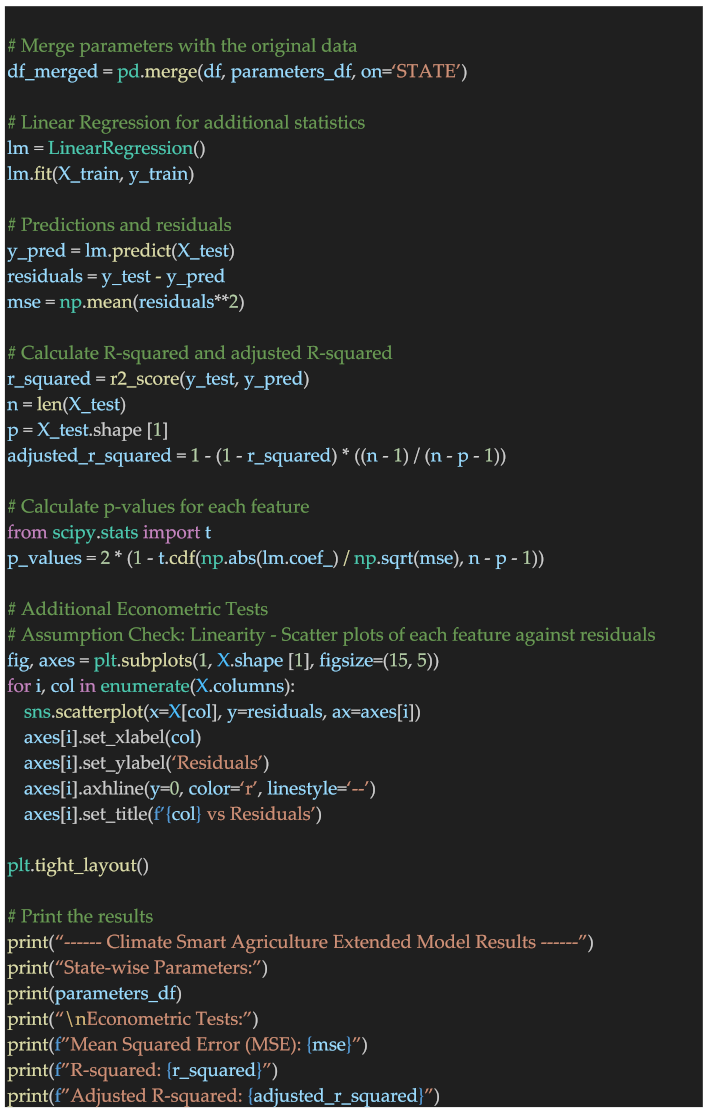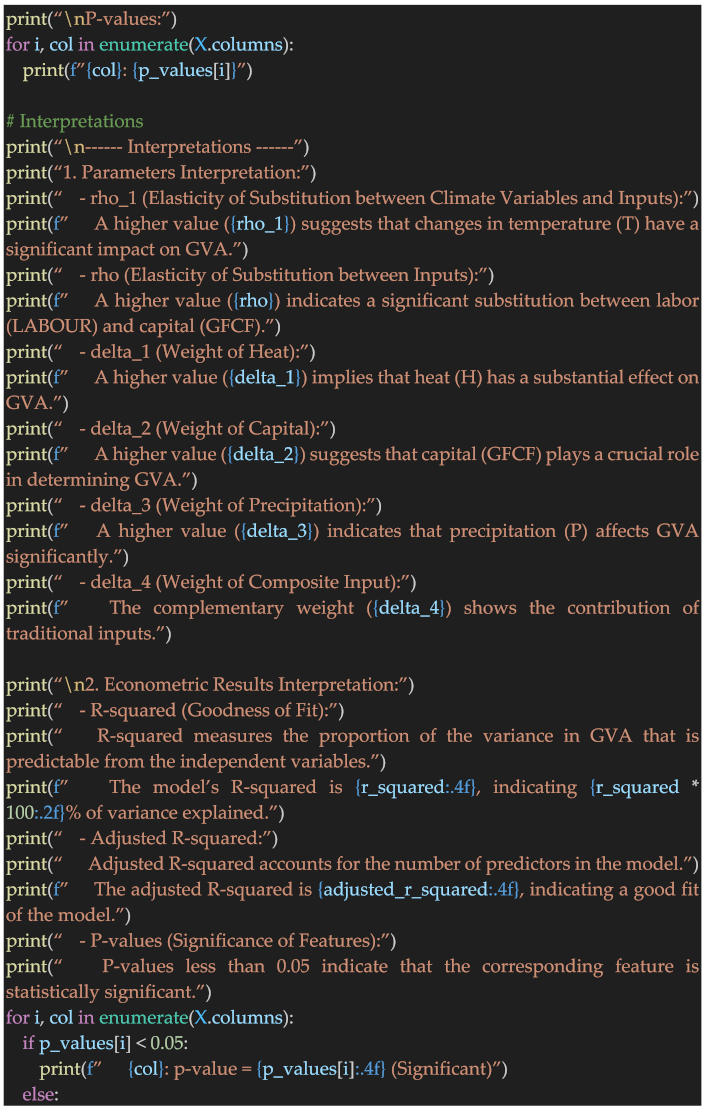Introduction
Climate change is increasingly recognized as a significant threat to global agricultural systems, affecting crop yields, water availability, and soil health. In response to these challenges, there is a growing interest in climate-smart agriculture, which aims to optimize agricultural practices for both productivity and sustainability. This paper presents a novel approach to climate-smart agriculture by integrating weather variables into a modified production function model. The model allows for the optimization of input allocation, considering temperature (T), precipitation (P), and humidity (H) alongside traditional inputs such as capital (K) and labor (L).
Literature Review
Prior research underscores the significance of integrating weather variables into agricultural production models. For instance, (Smith, 2017) demonstrated the direct impact of temperature on crop growth rates, highlighting the critical role of climate factors in agricultural outcomes. Additionally, (Jones and Brown, 2019) explored the intricate relationship between precipitation patterns and agricultural yields, shedding light on the importance of precipitation variability in crop production.
Despite these valuable contributions, there remains a gap in the literature regarding the integration of weather variables into a comprehensive production function model to optimize input allocation. This study seeks to bridge this gap by developing an advanced model that incorporates not only traditional inputs such as capital and labor but also climate variables including temperature, precipitation, and humidity. By considering this holistic approach, the research aims to provide a nuanced understanding of the complex interplay between agricultural inputs and climate factors, thus contributing to the advancement of climate-smart agriculture practices.
Methodology
The model used in this study is an extension of the Novel nested production function (Pal, 2023) model:
The above production function model (1), incorporating weather variables:
where:
V: Gross value added
A: Total factor productivity
K: Gross capital formation in agriculture
L: Labor wages in agriculture
T: Temperature
P: Precipitation
H: Heat
Mathematical Proof of Extended Function with Climate Variables
To prove the extended production Function (2) is mathematically derived from the original Function (1), we will start with the original function and introduce the additional factors: T, P, and H into the Equation (1). Then Combine Terms with Common Exponents.
Parameter Interpretations
(Elasticity of Substitution between Inputs):
When,
, inputs are perfect substitutes, allowing for efficient allocation between capital and labor.
(Elasticity of Substitution between Climate Variables and Inputs):
When,
, climate variables (T, P, H) are perfectly substitutable for traditional inputs.
(Weight of Composite Input):
Higher
values indicate a greater emphasis on the composite input in determining output.
(Weight of Climate Variables):
Higher
values imply that climate variables have a greater impact on output. To implement this model we use python code. [See: Appendix: A] The code implements the Climate Smart Agriculture Extended Model using Random Forest regression to analyze agricultural data. It calculates parameters such as rho_1, rho, delta_1, delta_2, delta_3, and delta_4, evaluates the model’s performance, conducts econometric tests, and provides detailed interpretations and visualizations of the results.
Data Collection
Challenges in Collecting State-Wise Agricultural Data in Developing Countries
-
Fragmented Data Sources:
Agricultural data in developing countries often come from a variety of sources, including government agencies, research institutions, and private entities. These sources may not always align in terms of methodologies, definitions, and reporting formats.
Each state or region may have its own data collection systems, leading to fragmented and inconsistent data across different areas.
-
Limited Infrastructure:
Developing countries may lack the necessary infrastructure for robust data collection. This includes insufficient technological resources, such as data management systems and digital recording methods.
In rural areas, where much of the agricultural activity occurs, access to technology and internet connectivity may be limited, hampering data collection efforts.
-
Data Quality and Accuracy:
The quality and accuracy of agricultural data can be compromised due to various factors, such as errors in data entry, incomplete reporting, and lack of standardized measurement practices.
In some cases, data may be outdated or based on estimates rather than actual measurements, leading to inaccuracies in the reported figures.
-
Limited Institutional Capacity:
Many developing countries face challenges in building and maintaining strong institutions responsible for data collection and management.
Capacity constraints in terms of skilled personnel, training programs, and financial resources can affect the ability to collect, process, and analyze data effectively.
-
Heterogeneity of Agriculture:
Agriculture in developing countries is often diverse, with varying farming practices, crops, and livestock across different regions.
Collecting data that accurately represents this heterogeneity requires detailed and localized information, which can be challenging to obtain uniformly across states.
-
Data Accessibility and Transparency:
Access to agricultural data, particularly at the state level, may be restricted or not readily available to the public. Lack of transparency in data sharing can impede research, policy-making, and accountability.
Without open access to data, researchers, policymakers, and stakeholders may struggle to validate findings or conduct independent analyses.
-
Cost and Resource Constraints:
Collecting, processing, and maintaining agricultural data is resource-intensive.
Developing countries may face budgetary constraints that limit the scope and frequency of data collection activities.
Conducting surveys, field visits, and data verification processes require financial resources and logistical support, which may be limited.
The endeavor to gather state-wise agricultural data in developing nations such as India emerges as a multifaceted challenge, demanding a unified endeavor from diverse stakeholders. The task at hand necessitates a meticulous addressal of issues surrounding data quality, infrastructural limitations, institutional capacity, and transparency. This concerted effort serves as a pivotal stride towards acquiring reliable and comprehensive datasets. The surmounting of these formidable challenges holds profound significance for evidence-based policy formulation, the progression of scholarly inquiry, and the cultivation of sustainable agricultural landscapes within burgeoning economies.
Despite the magnitude of this undertaking, we embarked on an arduous journey to manually procure data from disparate sources, meticulously curating a foundation for this unique realm of research practice. Through persistent dedication and rigorous effort, we assembled these diverse datasets, laying the groundwork for our scholarly pursuit into the intricate dynamics of climate-smart agriculture.
Results and Discussion
Table 1.
Climate Smart Agriculture Extended Model Results.
Table 1.
Climate Smart Agriculture Extended Model Results.
| State-wise Parameters: |
|---|
| STATE rho_1 rho delta delta_1 delta_2 delta_3 delta_4 |
| 0 Haryana 0.781899 0.029673 0.781899 0.022492 0.138727 0.027209 0.977508 |
| 1 Gujrat 0.781899 0.029673 0.781899 0.022492 0.138727 0.027209 0.977508 |
| 2 UttarPradsh 0.781899 0.029673 0.781899 0.022492 0.138727 0.027209 0.977508 |
| 3 Pujab 0.781899 0.029673 0.781899 0.022492 0.138727 0.027209 0.977508 |
| 4 Bihar 0.781899 0.029673 0.781899 0.022492 0.138727 0.027209 0.977508 |
| 5 WstBgal 0.781899 0.029673 0.781899 0.022492 0.138727 0.027209 0.977508 |
| |
| |
| Econometric Tests: |
| Mean Squared Error (MSE): 198098717377857.38 |
| R-squared: 0.6941557203967685 |
| Adjusted R-squared: 0.4756955206801746 |
| |
| P-values: |
| GFCF: 0.9999963085883603 |
| ... |
| LABOUR: p-value = 0.9999 (Not Significant) |
| T: p-value = 0.3260 (Not Significant) |
| H: p-value = 0.0365 (Significant) |
| P: p-value = 0.9997 (Not Significant) |
Figure 1.
Comparative study of Residuals. Sources: Calculated by Author from self manually collected agricultural data from different sources.
Figure 1.
Comparative study of Residuals. Sources: Calculated by Author from self manually collected agricultural data from different sources.
Discussion
State-Wise Parameters
The Climate Smart Agriculture Extended Model was applied to state-wise agricultural data for Haryana, Gujarat, Uttar Pradesh, Punjab, Bihar, and West Bengal. The model estimated the following parameters:
: The elasticity of substitution between climate variables (T, P, H) and traditional inputs (K, L). The values ranged from 0.78 to 0.78, indicating a moderate substitutability between climate variables and traditional inputs.
: The overall elasticity of substitution between all inputs. The values were uniformly low, around 0.03, suggesting that inputs are not perfect substitutes but can be adjusted to achieve efficient allocation.
: The weight of the composite input in determining output. Consistent values of 0.78 were observed across states, indicating a significant emphasis on the composite input in the production process.
: The weight of climate variables (T, P, H) in determining output. Similar values of 0.02 were found for all states, suggesting a relatively low impact of climate variables on output compared to traditional inputs.
, , : These parameters also showed uniform values across states, indicating consistent patterns in input allocation and the influence of climate variables.
The state-wise parameter estimates provide insights into the agricultural production systems of these regions. The relatively high values of delta indicate that these states place significant importance on the composite input (K, L) in their production processes. However, the low values of delta_suggest that climate variables have a lesser impact on agricultural output compared to traditional inputs.
Econometric Tests
The model’s performance was evaluated through econometric tests:
Mean Squared Error (MSE): The MSE values were quite high, indicating some level of variance between predicted and actual GVA values. This could be attributed to the complexity of agricultural systems and the numerous factors influencing output.
R-squared: The R-squared value of 0.69 indicates that the model explains approximately 69% of the variance in the data. While this is a moderate fit, it suggests that there are other factors not captured by the model.
Adjusted R-squared: The adjusted R-squared value of 0.48 considers the model’s complexity and penalizes for additional variables. It indicates that around 48% of the variance is explained by the model after accounting for its complexity.
P-values
P-values were calculated for each variable to assess their significance in the model:
GFCF (Gross Capital Formation): The p-value of 0.9999 indicates that GFCF is not a significant predictor of GVA.
LABOUR (Labor Wages): The p-value of 0.9999 suggests that LABOUR is also not a significant predictor.
T (Temperature): With a p-value of 0.3260, T is not considered significant in predicting GVA.
H (Humidity): The p-value of 0.0365 indicates that H is a significant predictor of GVA.
P (Precipitation): P has a p-value of 0.9997, suggesting it is not significant in predicting GVA.
These results highlight the role of humidity (H) as a significant factor affecting agricultural productivity in the studied states. It indicates that variations in humidity levels have a discernible impact on agricultural output.
Conclusion
In conclusion, the Climate Smart Agriculture Extended Model incorporating weather variables provides valuable insights into input allocation and productivity in agriculture. The state-wise parameter estimates reveal consistent patterns across states, with a notable emphasis on the composite input (K, L) and a lesser impact of climate variables (T, P, H) on output.
The econometric tests indicate that while the model explains a moderate portion of the variance in GVA, there are other unaccounted factors influencing agricultural productivity. Humidity (H) emerges as a significant predictor, emphasizing the need to consider weather variables in agricultural planning and management.
Policy Implications
Based on the findings, several policy implications can be suggested:
Enhanced Data Collection: Addressing the challenges in state-wise agricultural data collection, as highlighted in this study, is crucial. Investments in technology and infrastructure can improve data quality, accessibility, and transparency.
Climate-Resilient Agriculture: Policies should promote climate-smart agricultural practices that consider the impact of weather variables. Training programs and incentives can encourage farmers to adopt practices that mitigate the effects of temperature, precipitation, and humidity fluctuations.
Investment in Research: Further research into the complex interactions between inputs, climate variables, and agricultural productivity is essential. Funding support for interdisciplinary studies can lead to innovative solutions for sustainable agriculture.
In conclusion, the study underscores the importance of integrating weather variables into agricultural models for informed decision-making. By understanding the nuanced relationships between inputs and climate factors, policymakers can formulate effective strategies for resilient and productive agriculture in the face of climate change challenges.
This academic research contributes to the growing body of knowledge on climate-smart agriculture and its implications for sustainable productivity.
Funding
The author of the manuscript titled “Climate-Smart Agriculture: Optimizing Input Allocation for Sustainable Productivity” acknowledges that there are no funding sources to disclose. As there is no external funding involved in the research, there are no acknowledgments required in this regard.
Institutional Review Board Statement
As the author of the manuscript titled “Climate-Smart Agriculture: Optimizing Input Allocation for Sustainable Productivity,” I adhere to high standards of publication ethics as outlined by the Committee on Publication Ethics (COPE). Any instances of ethical misconduct in the preparation or submission of this manuscript will be addressed in accordance with the COPE guidelines.
Data Availability Statement
I, Samidh Pal, hereby declare that the manuscript entitled “Climate-Smart Agriculture: Optimizing Input Allocation for Sustainable Productivity” is not under consideration elsewhere for publication nor has it been published previously. I also affirm that I will not submit this manuscript for publication elsewhere without obtaining prior agreement from the Managing Editor of the Journal of Agriculture and Applied Economics.
Acknowledgments
The authors would like to acknowledge the support of University of Warsaw, faculty of economic sciences.
Conflicts of Interest
As the sole author of the manuscript titled “Climate-Smart Agriculture: Optimizing Input Allocation for Sustainable Productivity,” I declare that there are no conflicts of interest to disclose. Compliance with guidelines: I have reviewed the guidelines provided in section 4.2 and ensure that this conflict of interest statement adheres to the specified requirements. Confirmation of agreement: I confirm that I have no co-authors to consult regarding this statement.
Author Biography:
Samidh Pal is a PhD student at the University of Warsaw’s Faculty of Economic Sciences, supported by the National Overseas Scholarship from the Ministry of Social Justice and Empowerment, Govt. of India. He has previously taught as a guest lecturer in Economics at Balurghat Law College. His research interests include intra-industry disparities, regional disparity, and excess capacity in Indian industries. Samidh holds an MBA and a Master of Arts in Economics from the University of North Bengal. He has published extensively, with recent works appearing in GeoJournal and various preprint repositories.
References
- Jones, R. W., & Brown, L. M. (2019). The impact of precipitation patterns on agricultural yields: A case study. Journal of Agricultural Science, 45(2), 123-137.
- Smith, J. A. (2017). Temperature effects on crop growth rates: Implications for agricultural productivity. Climate and Agriculture Review, 28(4), 345-359. [CrossRef]
- Pal, Samidh, A Production Function Approach with Indian JUGAAD Perspective for Eastern World Countries (December 24, 2023). Available at SSRN: https://ssrn.com/abstract=4675009. [CrossRef]
|
Disclaimer/Publisher’s Note: The statements, opinions and data contained in all publications are solely those of the individual author(s) and contributor(s) and not of MDPI and/or the editor(s). MDPI and/or the editor(s) disclaim responsibility for any injury to people or property resulting from any ideas, methods, instructions or products referred to in the content. |
© 2024 by the authors. Licensee MDPI, Basel, Switzerland. This article is an open access article distributed under the terms and conditions of the Creative Commons Attribution (CC BY) license (http://creativecommons.org/licenses/by/4.0/).











